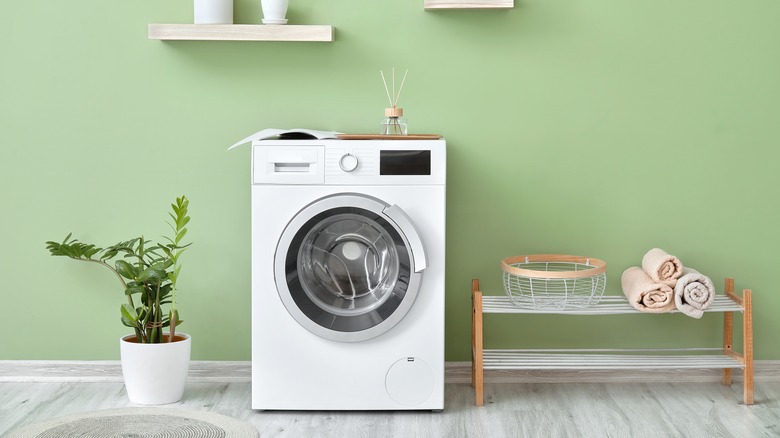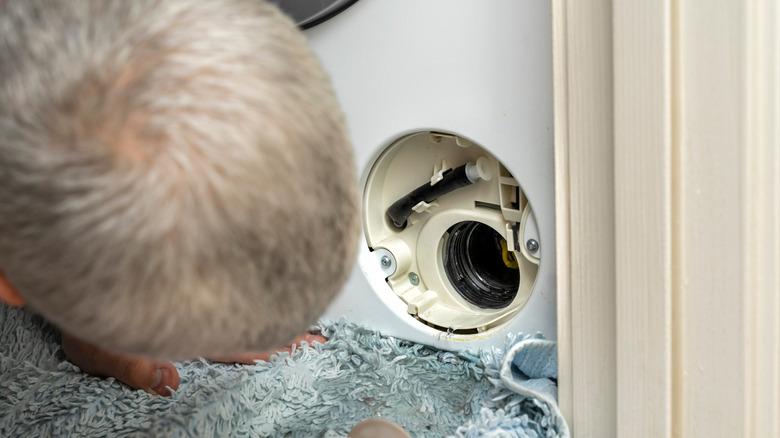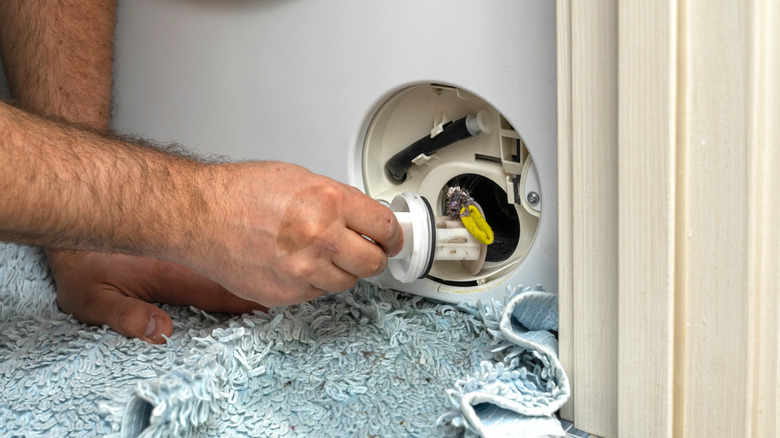The Part Of Your Washing Machine You Should Make Sure To Clean
Your washing machine is a valuable asset to your home that saves your household ample time throughout the course of its life. But unlike the other appliances located around your house, it probably isn't cleaned as exhaustively as it should be. For appliances with exposed surfaces like refrigerators, microwaves, and stovetops, regular cleanings are more feasible and often factored into a homeowner's everyday housekeeping routine. Even a dryer's filter sees a consistent refresh throughout its service life, as it's customary to clean the lint trap after every cycle to avoid fires. However, when it comes to your washer, you might not even think the machine needs proper cleaning, much less know where to begin. As a rule of thumb, strive to keep your washing machine's filter clean between uses, preferably removing any accumulated debris every 1 to 2 months.
Cleaning your washer's filter is a simple way to ensure that the machine drains water effectively and cleans your clothes thoroughly while in use. Allowing lint and other litter from your laundry to build up inside the filter for too long can cause your machine to suffer mechanical issues and may lead to dirty clothes and linens even after a cycle is complete. Fortunately for homeowners, this preventive maintenance step doesn't require help from a professional. Whether you wash clothes daily or just once every week or two, it's crucial to clean the filter to keep your appliance operating at its best.
Why cleaning your washer's filter matters
The washing machine filter is a mechanism that traps dirt, lint, and other waste that falls off your laundry as the machine washes it. Also called a drain pump filter, the piece protects the washing machine's drain pump from debris that enters the wastewater, which allows the appliance to properly drain all used water after a wash cycle. Without the filter, much of this litter would flow directly into the washer's drain pump, clogging it and preventing the machine's tub from emptying of water as the cycle nears its end. However, keep in mind that some newer models may not have a filter and may be self-cleaning. While you could still check on the water pump, these types don't require as much maintenance.
If your washer has a filter, neglecting to clean it can impact the way the machine cleans loads. A clogged filter will cause more waste to infiltrate your clothes and linens, which may lead to them smelling unclean even after a full wash. This waste isn't limited to dirt alone, as residue from your detergent can also end up on your laundry, since the congested filter will likely cause the used water to drain at a slower rate than usual. This could also cause mold growth that could lead to health problems. Clogged filters force washing machines to use more energy than normal to operate, which can mean higher electricity bills for homeowners who clean their filters less often.
How to clean your washer's filter
In order to build a habit of cleaning your washing machine's filter, it's imperative to figure out where it is. The location of your washer's filter usually depends on whether the machine is front-loading or top-loading. With front-loading models, manufacturers sometimes place the filter at the bottom right-hand corner of the machine's front. However, with top-loading models, filters may be found underneath the machine's agitator, which is located at the bottom of the washer's drum. You may need to refer to your washer's manual to find out where the filter is located (or if it even has one), as no two washer models are exactly the same.
To clean your filter, start by taking it out of the machine as recommended by the model's maker. Releasing the filter might also release some water from its chamber, so place a small bowl and some towels underneath the compartment's opening to protect your floor from spills. Next, extract any oversized pieces of debris from the filter using your fingers, if possible. Once this waste is removed, soak the filter in warm water mixed with mild detergent for about 10 minutes before grabbing a used toothbrush to scrub any hard-to-reach pieces. Finally, insert the filter back into its chamber to prepare for the machine's next wash. You may also want to run a short cycle to ensure the filter was correctly inserted back in place.


